Diatomic - Study guides, Class notes & Summaries
Looking for the best study guides, study notes and summaries about Diatomic? On this page you'll find 509 study documents about Diatomic.
Page 4 out of 509 results
Sort by
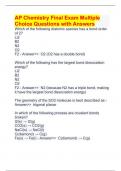
-
AP Chemistry Final Exam Multiple Choice Questions with Answers
- Exam (elaborations) • 11 pages • 2024
- Available in package deal
-
- $12.99
- + learn more
AP Chemistry Final Exam Multiple Choice Questions with Answers Which of the following diatomic species has a bond order of 2? Li2 B2 N2 O2 F2 - Answer>> O2 (O2 has a double bond)
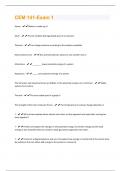
-
CEM 141-Exam 1 Questions With Correct Answers Already Passed!!
- Exam (elaborations) • 8 pages • 2023
- Available in package deal
-
- $7.99
- + learn more
Atoms - Matter is made up of Atom - The the smallest distinguishable part of an element Theories - Can change overtime according to the evidence available Electrostatic forces - ALL atoms/molecules attract to one another due to Attractions - ________ lower potential energy of a system Repulsions - _____ raise potential energy of a system The attractive and repulsive forces are EQUAL or the potential energy is at a minimum - Stable systems form where The well - The most stable part of a g...

-
HESI A2 Chemistry Questions with Answers and Explanations UPDATED
- Exam (elaborations) • 15 pages • 2023
- Available in package deal
-
- $13.99
- + learn more
HESI A2 Chemistry Questions with Answers and Explanations UPDATED 1. Which of the following substances allows for the fastest diffusion? A. gas B. solid C. liquid D. plasma Explanation: Diffusion is fastest through gases. The next fastest medium for diffusion is liquid, followed by plasma, and then solids. In chemistry, diffusion is defined as the movement of matter by the random motions of molecules. In a gas or a liquid, the molecules are in perpetual motion. For instance, in a quan...
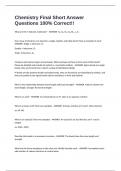
-
Chemistry Final Short Answer Questions 100% Correct!!
- Exam (elaborations) • 6 pages • 2024
- Available in package deal
-
- $15.99
- + learn more
What are the 7 diatomic molecules? - ANSWER H₂, O₂, N₂, Cl₂, Br₂, I₂, F₂ How many of electrons are shared in a single, double, and triple bond? Give an example of each - ANSWER Single: 2 electrons, H₂ Double: 4 electrons, O₂ Triple: 6 electrons, N₂ Compare and contrast sigma and pi bonds. What overlaps and how to form each of the bonds? Please be detailed and include the hybrid vs. non-hybrid orbitals. - ANSWER Sigma bonds are single bonds, they are formed from a ...
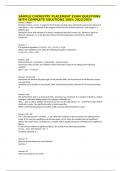
-
SAMPLE CHEMISTRY PLACEMENT EXAM QUESTIONS WITH COMPLETE SOLUTIONS 100% 2023/2024
- Exam (elaborations) • 10 pages • 2024
-
- $10.29
- + learn more
SAMPLE CHEMISTRY PLACEMENT EXAM QUESTIONS WITH COMPLETE SOLUTIONS 100% 2023/2024 Answer: Oxygen Aluminum forms a +3 ion. In order for the formula unit Al₂X₃ to be electrically neutral, the element X must form a -2 ion. Nonmetals in the oxygen column do this. Of these elements, only oxygen is a diatomic gas. Aluminum reacts with element X to form a compound with the formula A₂X₃. Element X exists as diatomic molecules, X₂, in the gaseous state at normal temperature and pressure. Elem...
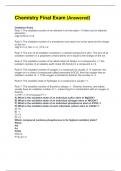
-
Chemistry Final Exam (Answered)
- Exam (elaborations) • 34 pages • 2023
-
- $13.49
- + learn more
Chemistry Final Exam (Answered) Oxidation Rules Rule 1: The oxidation number of an element in its free state = 0 (Also true for diatomic elements) -Mg=0,H2=0, C=0 Rule 2: The oxidation number of a monatomic (one-atom) ion is the same as the charge on the ion -Mg^2+=+2, Na^+=+1, O^2-=-2 Rule 3: The sum of all oxidation numbers in a neutral compound is zero. The sum of all oxidation numbers in a polyatomic (many-atom) ion is equal to the charge on the ion. Rule 4: The oxidation numb...

-
Sample Chemistry Placement Exam Questions and Answers 2024/2025
- Exam (elaborations) • 9 pages • 2024
-
- $11.99
- + learn more
Sample Chemistry Placement Exam Questions and Answers 2024/2025 Answer: Oxygen Aluminum forms a +3 ion. In order for the formula unit Al₂X₃ to be electrically neutral, the element X must form a -2 ion. Nonmetals in the oxygen column do this. Of these elements, only oxygen is a diatomic gas. Aluminum reacts with element X to form a compound with the formula A₂X₃. Element X exists as diatomic molecules, X₂, in the gaseous state at normal temperature and pressure. Element X must b...

-
Chemistry 101 Final Ivy Tech Exam Questions With Correct Answers
- Exam (elaborations) • 16 pages • 2024
-
- $7.99
- + learn more
Chemistry 101 Final Ivy Tech Exam Questions With Correct Answers Diatomic O2 can react with the element magnesium to form magnesium oxide (MgO). The balanced chemical equation is: O2 + Mg ⟶ 2 MgO If 4 moles of magnesium totally reacted with more than enough O2, how many moles of MgO would be expected to form? A. 8 Moles B. 2 Moles C. 4 Moles D. 1 Mole E. Not Enough Info - Answer C Which of the following is TRUE? A. Stoichiometry allows prediction of how much of the reacta...
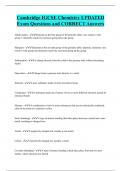
-
Cambridge IGCSE Chemistry UPDATED Exam Questions and CORRECT Answers
- Exam (elaborations) • 8 pages • 2024
-
- $7.99
- + learn more
Alkali metals - Elements in the first group of the periodic table; very reactive with group 7 elements; reactivity increases going down the group Halogens - Elements in the seventh group of the periodic table; diatomic elements; very reactive with group one elements; reactivity increases going up the group Sublimation - A change directly from the solid to the gaseous state without becoming liquid Deposition - Change from a gaseous state directly to a solid Element - A pure substance ma...
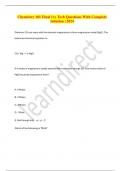
-
Chemistry 101 Final Ivy Tech Questions With Complete Solution | 2024
- Exam (elaborations) • 36 pages • 2024
-
- $10.49
- + learn more
Chemistry 101 Final Ivy Tech Questions With Complete Solution | 2024 Diatomic O2 can react with the element magnesium to form magnesium oxide (MgO). The balanced chemical equation is: O2 + Mg ⟶ 2 MgO If 4 moles of magnesium totally reacted with more than enough O2, how many moles of MgO would be expected to form? A. 8 Moles B. 2 Moles C. 4 Moles D. 1 Mole E. Not Enough Info - - C Which of the following is TRUE? A. Stoichiometry allows prediction of how much of the reactants are ne...

How did he do that? By selling his study resources on Stuvia. Try it yourself! Discover all about earning on Stuvia


